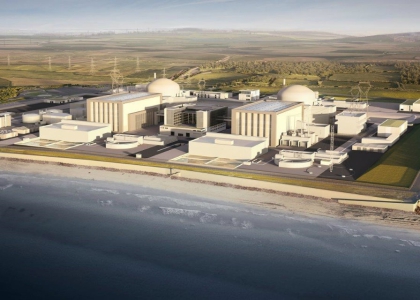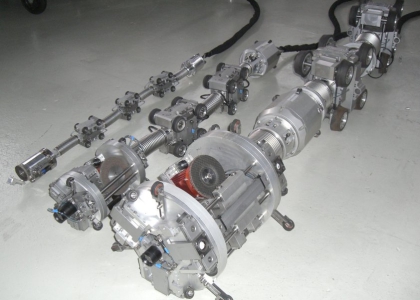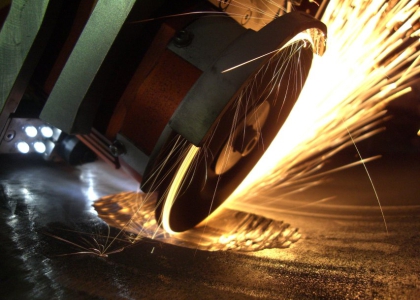Major order for British NPP: Robot technology ensures quality of the nuclear steam supply system
The Hinkley Point nuclear power plant in the south-west of England, located on the Bristol Channel, currently consists of two plant sections, Hinkley Point A and Hinkley Point B. The Hinkley Point C part of the plant will receive two new pressurised water reactors of the type EPR (European Pressurised Reactors), similar in design to those already supplied to Finland, France and China. With a net capacity of 1,600 MW each, these two reactor units will be included amongst the ten most powerful in the world.
The dual reactor plant is being built by the French energy group EDF in cooperation with the Chinese project partner China General Nuclear Power (CGN). For this project, the industrial services provider Bilfinger was given a significant role and selected as a strategic supplier (Tier 1) for the Hinkley Point C project. The extensive orders for various services include the manufacture and assembly of piping and equipment for the nuclear steam supply system, or NSSS for short. Nuclear power plants with pressurised water reactors always consist of two parts:
- a nuclear island that houses the NSSS and whose main task is to supply steam (primary circuit),
- and a conventional, non-nuclear island that is used to generate electricity and whose turbines are driven by the steam (secondary cycle).
The nuclear steam supply system (NSSS) is the part of the nuclear power plant that is used to generate steam to supply the turbine generator units, which in turn generate the electricity. Thereby, the high-pressure piping of the NSSS for the corresponding water-steam circuits must meet the highest safety standards. A prerequisite for this is the best possible welded joints, which are subject to a defined specification. INSPECTOR SYSTEMS, with its recognised and proven grinding robot technology, has been the worldwide specialist known for "internal finishing touches" for almost 40 years.
Robot fleet for pipeline sizes from DN 100 to DN 750
There is sufficient experience and Know-How on what is important in this project. INSPECTOR SYSTEMS' pipe robot technology has been used in all previous EPR reactor construction projects. Also for Hinkley Point C, pipe robots from us will be used again to carry out the necessary work.
For the internal machining and inspection of the safety-relevant weld seams of the nuclear steam supply system (NSSS), the Bilfinger company commissioned us to build an entire fleet of pipe robots, consisting of a total of 14 special devices with different applications. For the pipe sizes DN 100, DN 150 to 200, DN 250 to 350, DN 400 to 500, a grinding robot including a visual inspection camera, an extraction robot and a laser scanning robot will be supplied in each case.
A special feature is the DN 750 pipe size. A grinding robot is also produced for this, but the suction and laser scanning is done by a specially developed combination robot, which enables both applications.
More than ten years ago, in the Olkiluoto EPR project in Finland, INSPECTOR SYSTEMS and Bilfinger - at that time still active in nuclear power plant construction under the former pipe construction division BHR Hochdruck Rohrleitungsbau GmbH - already cooperated. INSPECTOR SYSTEMS pipe robots were also used at that time and were able to successfully meet the requirements.
High demands on the quality of safety-relevant weld seams/h4>
Weld seams in sensitive areas of nuclear power plants must meet the high requirements of the safety regulations. Targeted grinding of the internal weld roots during pipeline assembly increases the quality of the pipeline and makes it much easier to carry out the recurring inspections later during operations.
The prerequisite is that certain specifications are met. This specify that the surface of a weld root must not exceed a roughness mean value of 6.3 μm. The angles of the flanks, which result from the edge offset of the pipeline, must be less than 7°. This is a highly complex machining process which can be carried out by the specially developed grinding robots from INSPECTOR SYSTEMS down to the tenth of a millimetre range.
In the ground area, the remaining wall thickness must not fall below the nominal wall thickness and contamination of the pipe must be avoided. The resulting residues of grinding dust are then extracted by special extraction robots, which ensure that the pipe systems are in a clean condition. In order to ensure that the grinding meets the specified requirement, the laser scanning robot is used to record the axial profile of the weld seam at several angular positions and this is logged by the software.
Only when the basic work has been completed can further acceptance tests of a visual and X-ray nature be carried out.
Sophisticated robot technology for highly precise applications
A pipe robot from INSPECTOR SYSTEMS, in its basic concept a modular design, is a highly developed machine that has been refined and matured over the decades. It consists of hundreds of individual mechanical, electrical and pneumatic parts, some with very specific geometries, which are seamlessly joined together and adapted to each other.
The basis for the modular design is one or more drive units. These have extendable wheel carriers that centre and stabilise the robot in the pipe by means of an adjustable pre-tension. It is this design that makes it possible to reach hard-to-reach places in the pipe that are located behind bends with a bending radius of 1.5 D, vertical pipe sections, diameter reductions or branches.
In combination with an application module, precise machining and testing of weld seams at any desired angle in the pipe circumference is possible. For this purpose, specially developed grinding, suction or laser scanning modules with integrated centring/stabilising mechanisms and high-precision 360° rotating units as well as specific adjustability of their application elements in axial-radial direction (grinding wheel, suction nozzle or laser) are used.




